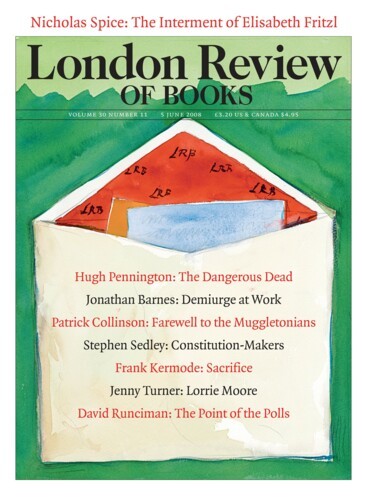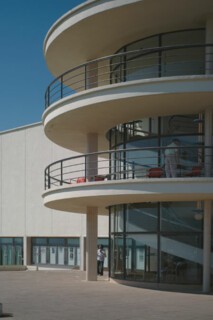Chapter titles in Light, Air and Openness, Paul Overy’s new look at modern architecture between the wars, describe the dream that the style underwrote: ‘The City in the Country’, ‘The House of Health’, ‘Built into the Sun’ and so on.* In the recently restored De La Warr Pavilion in Bexhill-on-Sea, a rare early example of the international style in England, the Modernist spirit has been so well revived that if more of those whom I saw eating and sunning themselves had been young and bronzed, not old and white-haired, and if the pavilion was not still surrounded by the brick terraces you see in the earliest photographs, you would have guessed that the planner’s dream had been achieved. Overy quotes Earl De La Warr, the socialist mayor of Bexhill who promoted the pavilion. It was, he said, ‘a venture which is part of a great national movement, virtually to found a new industry – the industry of giving that relaxation, that pleasure, that culture, which hitherto the gloom and dreariness of British resorts have driven our fellow countrymen to risk in foreign lands.’ Certainly, the Sussex coast on a hot day, seen through the glass wall of the spiral staircase, the pavilion’s brilliant, confidently conceived identifying feature, seemed infinitely preferable to any Mediterranean beach.
Unpopular Culture, a touring exhibition selected by Grayson Perry from the Arts Council Collection, mainly of pieces from the years 1940 to 1980, is at the pavilion’s gallery until 6 July. You look at art that reflects the reality of postwar England while surrounded by the architecture of prewar hopes. Perry sees the years ‘between the Blitz and the contemporary bombardment by media and marketing’ as a time when, as he puts it, our experience of ourselves had not become muffled. The import of the exhibition is that there are things to be learned from, or at least enjoyed in, the art of a parochial, un-international patch of the past when British art was quarantined by war and its aftermath.
The pavilion’s architecture is international, the work of two émigrés, Erich Mendelsohn and Serge Chermayeff. The things in the exhibition – paintings (mainly figurative), documentary photographs and bronze sculptures – like the half-dozen poems printed in the catalogue, represent a specifically English sensibility. Lines from the poems select images very like those the photographers looked for: Vernon Scannell (‘The tight-lipped woman who, accompanied/By all she knows of love on leather leash’), Tony Harrison (‘In each of our Blackpool photos from those years/and, I’ll bet, in every family’s South Pier snap’) and Philip Larkin (‘We passed them, grinning and pomaded, girls/In parodies of fashion, heels and veils’) hit the same sweetly rasping note as Tish Murtha’s unemployed man and his family in Newcastle, Martin Parr’s empty, rained-on tables for a Jubilee street party, Tony Ray-Jones’s group on deckchairs making the best of a cold day on Brighton Beach, Homer Sykes’s naked girls in a fairground peepshow. They all say ‘this is how we are,’ in black and white: something in colour – less wry but also less affectionate, a later picture by Martin Parr, say – would destroy the mood as surely as turning up the house lights in a theatre. Colour belongs to the media-bombarded visual world Perry’s exhibition looks back beyond.
Many of the paintings – Jack Smith’s black-grey-brown After the Meal, Ruskin Spear’s dusky Hammersmith Broadway, Victor Pasmore’s misty Riverside Gardens, Paul Nash’s bleak East Anglian sea wall in Promenade – are sadder and more solemn than the photographs. Sickert’s brown fog and a Whistlerian mist creep into them. Seeing them alongside the black and white photographs you might be tempted to factor in the need for a clean air act, or want to commiserate about the bad weather, as George VI did when he looked at John Piper’s drawings of Windsor Castle. You are struck by the observation of things that had not been seen before, or seen rarely, in pictures: things like the backs of the South London houses where Carel Weight set odd encounters that could have come from stories by Pritchett or Coppard – or even Angela Carter.
The exhibition gets its focus from being built round Perry’s experience of art. His fondness for things as they were when he first came into contact with them feeds back into his own work. He appears on the cover of the catalogue in a photograph that is an affectionate parody of photographs in the exhibition: cross-dressed in headscarf, high heels and gloves in a down-at-heel parking lot.†Queen’s Bitter, the large pot that is one of his two contributions to the exhibition, is decorated with other versions of that photograph and with black and white line drawings – acorns, a pearly king and queen, a pub table, a crown – that are a convincing imitation of the style of Edward Bawden’s linocuts. His other contribution, a more than life-size bronze skull, Head of a Fallen Giant, at first glance an exotic nail-studded fetish, turns out to be covered with low-relief images of staple subjects for tourist tat: a Routemaster bus, a Union Jack, Queen Elizabeth I, Big Ben, Tower Bridge and so forth. His response to the roughly worked surfaces and cloddish weight of the bronzes he has chosen – the almost featureless head by William Turnbull, for example, or the alien-like figure standing on three prongs by Lynn Chadwick – is to remember the circumstances in which he first saw them. ‘No matter how hard I try to supplant the thought, the principal association the sculptures I have selected bring to my mind is with childhood trips to concrete New Towns and their architecture of catastrophic optimism. Each bronze is to me an evocation of a guano-spattered plinth on a windswept shopping centre.’
Perry’s selection of pieces shapes a view of history through what it excludes. He has a suspicion that ‘the 1960s, in all its groovy glory, was really only enjoyed by a minority’ (so no Blake, Hamilton or Hockney). The things he has chosen, although not majority art, were sometimes attempts to address majority experience. Perry observes that ‘contemporary art, or at least going to contemporary art galleries, has attained mass appeal.’ A Turner Prize winner, he has profited in one way or another from that change, but is nostalgic for a time when ‘life was slower and when, maybe, we were more reflective, more civic and more humane’, when the latest art was not, as it often is now, ‘sensational, big, loud, shocking, funny’. By hanging photographs alongside paintings and anchoring the whole thing with anguished bronzes, Perry has created an exhibition that gives great pleasure; in it various kinds of not very fashionable art support one another, even gain a certain moral weight. They confront the beautifully restored building in which the exhibition is presently housed in a way that flatters its modern looks and points up the comparative shallowness of the social hopes that were tacked onto them.
Send Letters To:
The Editor
London Review of Books,
28 Little Russell Street
London, WC1A 2HN
letters@lrb.co.uk
Please include name, address, and a telephone number.


